Got a new litter box for your kitty but confused about how to get started? We help you with some tips on how to train a cat to use a litter box and its maintenance.
Cats make great pets. They are full of fun and love spending time with their owners. But one of the major efforts you may have to take as a feline parent is to train a cat to use a litter box.
It is necessary to do litter box training, and especially kittens to use the litter box each time for their shedding business to not go about peeing around the house and cultivate a habit of using the litter box.
We help you with some guidelines in order to train a cat to use a litter box along with a guide to choosing and maintaining a litter box for your feline to use it comfortably.
Litter Box Training: Train a Cat To Use a Litter Box
The best way to train a cat to use a litter box is with patience while also making sure that the box is appropriate, well maintained, and clean for your cat to use.
Having a cat at your house definitely means you need to have a litter box at dispense. In order for your cat to not pee or poop anywhere in the house, a litter box makes for a specific area where your cat can carry out his shedding activities.
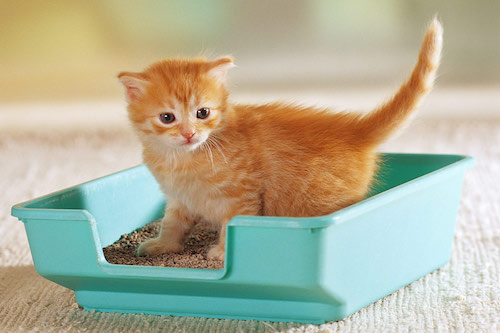
Adult cats usually learn quickly but a rescued cat or kitten may litter anywhere in the house. Therefore, we need to train them to use the litter box. Here is how you can get started.
-
Know your Cat’s Schedule
Cats usually prefer to relieve themselves after taking a nap, after excessive playing, or post a meal. Every cat will have different timings to poop and pee. Take note of these timings that will help you understand your kitty’s pee and poop schedule.
So, every time your cat feels like shedding around these hours, you know you have to direct him to the litter box instead of staying near the floor or the couch. That’s the first step of litter box training.
-
Introduce Your Cat to the Litter Box
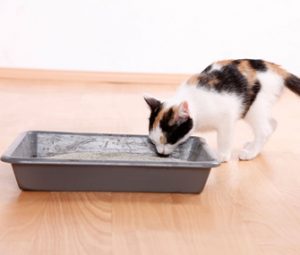
You will have to make your cat accustomed to the idea of using a box for which they need to be introduced and well versed with the litter box. Cats, especially kittens, take time to adapt to new things. Patiently explain the parts and components of the litter box to them.
Let them understand and sniff each corner of the litter box to get used to its environment and smell. After a few days, you can slowly place them in the litter box.
Cats may resist at first and run away or start playing with the litter inside or start digging their paws into the litter. This is a good sign since they need to bury their shedding into the litter.
You can also use treats in order to take your cat around the litter box. So each time they are around the box, they associate themselves with getting a treat and use it instinctively until it becomes a habit.
-
Train and Teach
Now comes the main task, train and teach. If your cat feels like pooping or if their poop time is close as per schedule, you may have to lift and place him in the litter box.
Cats usually prefer digging into the litter box and hide their sheddings. Therefore, you will have to teach them to dig with your fingers. Gently scrape some part of the litter which can help them understand how to use their paws to dig the litter in the box.
You can also place some litter on top of their poop to train them. This is to understand how to cover or bury their poop in the litter box. Kittens require a few weeks of litter box training while adult cats learn quickly out of instinct.
Do not try to grab their paws while training them to use the box. This can only scare them and make them anxious. Give them a treat each time they do actions correctly. This will generate a positive thought in their mind about the litter box.
-
Keep the Litter Box Clean
As much as you need to train your cat to use the litter box, it is also important to maintain the environment and surroundings where they litter. Do not allow the box to get too dirty very often and keeping scooping and replacing the litter from time to time.
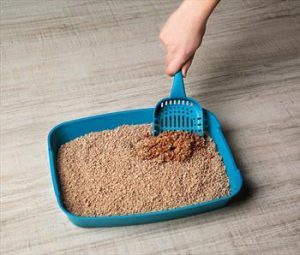
After removing the dirty litter, replace it with fresh, new litter having a depth of at least 2-3 inches for your cat to dig and burrow easily. Cleaning the litter box should be done periodically. The litter can be replaced entirely once a week. Clumping litter and clusters should be scooped daily.
Tips to Consider While Litter Training Your Cat
While training your cat to use the litter box can be challenging and test your patience, we give you some easy tips to consider in order to litter train your cat more efficiently and with ease.
-
Choosing the Litter Box
What is the point in litter box training, when you have not chosen the right box for him? Here is how you can choose a litter box by considering the following features.
-
Size
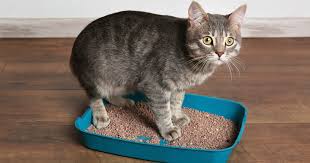
One of the major reasons why your cat won’t use the litter box is its size. If the place where it needs to litter is too small and snug for its activities, it would prefer going to a comfortable spot.
To remain on the safer side and to train your cat to use the litter box appropriately, always get a large-sized litter box. That ways, he would feel there is more room for his activities and the box does not fill up quickly.
You can also opt for a cat litter box with an automatic option.
-
Uncovered or Hooded
The type of litter box also determines if your cat would use it. Some cats prefer open places in secluded locations whereas few cats like it covered and secured. Generally, cats prefer an enclosed space for their shedding activities. Therefore, a hooded litter box would make them feel more in private.
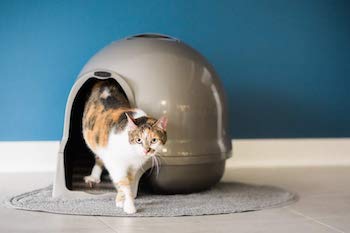
However, hooded boxes have their own disadvantages. First off, it will retain the poop smell for a long time as there is not much space for the odor to escape. This will only make the box more stinky and dirty and may cause your feline friend to stay away.
Moreover, if your pet is large, then entering and moving out of the box can also be uncomfortable for them. Therefore, an open litter box in a secluded corner of your house makes it private as well as convenient for your cat to use.
-
Location of the Litter Box
It is known that cats prefer shedding in quiet and secluded areas. Hence the litter box needs to be kept in undisturbed corners of the house where there is not much activity.
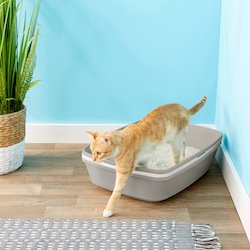
Moreover, it is important to understand that cats won’t look around for their litter box when they have sudden urges to poop or pee. Therefore, make sure to place a few litter boxes everywhere around the house to make it easily accessible for your pet.
Keep the litter box at common places where your cat visits. Do not keep them near their food and water bowls as they do not like to dirty the areas around their personal belongings.
-
Multiple Litter Boxes
If your house has multiple cats, then it is advisable to have the same number of litter boxes along with a few extra just in case one of them is too dirty and not suitable for use.
Cats do not like sharing litter boxes as they need their own private space for shedding. Therefore each cat should have their litter box assigned.
In addition, there are various cat litter options for multiple cat households.
If you have a small kitten, training him to use a litter box can be a task at first. Therefore, placing multiple litter boxes around the house makes it easy for them to understand and use them accordingly.
-
Litter Box Maintenance
Regular maintenance is a must if you want to train a cat to use a litter box. Therefore, before teaching your cat to use one, it is important to have the box ready for them so that they can use it each time they want to pee or poop.
-
Type of Litter
Cats have their own litter type preferences. Some like to dig into the ‘soft and tender’ type of litter to not harm their feet. Some like hard pieces and clusters to feed their digging instincts. In general, cats prefer clumping litter as it is easy to walk on it and burrow. These types of litter are also easy to clean.

There are various types of scented litter also available but cats usually deter from such fragrances. It is best to keep the litter natural and raw.
-
Amount of Litter
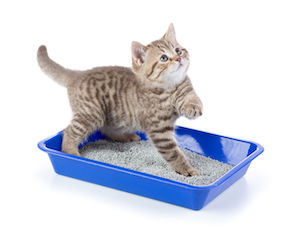
The amount of litter in the box is an equally significant factor for litter box maintenance. Too much litter would cause the contents to fall out of the box as cats tend to dig into it. This would only mess up the surroundings of the box.
Too less of litter in the box will not make your cat use it as he may feel there is not enough to bury their poop. This will cause them to litter somewhere else and make it difficult for you to clean.
Experts recommend filling the litter box with about two to four inches of litter. You can initially start by filling up the box for up to two inches. If your cat wants to bury deeper, you can fill it up to four inches.
-
Cleaning and Replacing the Litter

If you want your cat to maintain the habit of using the litter box every time he poops or pees, it is important to keep the litter box clean and replace the litter from time to time. If there are too many clumps or clusters that you see, scoop the litter out and replace it with fresh litter.
It is recommended to remove the litter daily and replace it with fresh litter to keep it as clean as possible.
Before placing clean litter, you need to wash the litter box at least once a week. Make sure to wash it with a mild detergent or soap and warm water. Avoid using harsh chemicals or fragrant detergents as this will only deter your cat from using the box and may cause allergies.
-
Addressing Issues
While having to train your cat to use the litter box, you require a lot of patience. Your cat may not oblige or co-operate at first which is quite normal as they take time to adjust to new habits and surroundings. Here is what you can do to train your cat to use a litter box patiently.
-
Keep Calm
Remember, your cat is not shedding out of the litter box on purpose. You need to train a cat to use a litter box with patience and by keeping calm. If they do not obey you, do not yell or shout at them as this will only make them feel more scared and anxious.
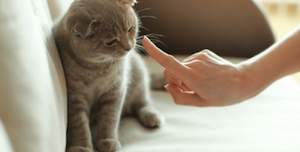
Ultimately, they will end up shedding anywhere outside the litter box. Teaching them with patience and keeping a friendly approach is more effective than scolding them.
-
Pick the Waste
One of the few ways to train your cat to use the box is to put their waste where it belongs, in the litter box. The smell of their waste would attract them to use the litter box for their shedding activities and is an effective way to train them to use the box often.
-
Move their Food and Water Bowls
If your cat has found a spot outside the litter box where he prefers shedding, move their food and water bowls close to that spot. Cats have an impulsive habit of not dirtying their personal belongings and this will only keep them away from other spots, thereby, making them use the litter box.
-
Clean Waste Outside the Litter Box
If your cat has accidentally pooped around the box, clean the waste outside the litter box as soon as possible before it gets too late. Cats associate habits with an odor and the litter smell would attract them further to shed in a particular area.

Do not allow the litter and its smell to linger around unnecessarily and clean it using an enzyme-based detergent or floor cleaner. This will get rid of the smell and remove germs from the area.
Alternatively, you can also place undesirable floor mats, textures, or even plastics or aluminum foils that make a crackling sound that cats usually deter from.
Read more
What If Your Cat Is Not Using The Litter Box
After trying to train a cat to use a litter box for quite a while, if they fail to cooperate and learn, here are a few steps you can try in your training process.
- Check the litter box set up as each cat has his own preferences when it comes to the type and location of the box. This also includes the type of litter used.
- Scoop the litter more frequently out of the box.
- Consider using fragrances that attract your cat towards the litter box, like their favorite treat. You can also use pheromone diffusers to make them feel that they have marked their territory and keep them relaxed.
- Consider visiting a veterinarian to check for any infections or medical problems. Sometimes, urinary tract infections or inflammations as well as hormonal imbalances due to anxiety or stress can make your cat shed anywhere apart from its litter box.
- Discuss litter training issues with your vet as they understand your pet’s troubles better.
- Most importantly, remain calm and patient while having to train a cat to use a litter box.
FAQs
How long does it take to train a cat to use a litter box?
Usually, it requires around 3-4 weeks of time to train a cat to use a litter box. While adult cats learn to use a litter box quite easily, kittens may take time. Ideally, kittens can learn to use a litter box from their mother. Else, you need to be patient for a few weeks to train them.
How do I potty train my cat?
Potty training your cat will require you to use a litter box with an appropriate amount of litter. Cats have a natural instinct of digging their poop into sand or mud and a box full of litter keeps their instincts alive. Make sure to have a good amount of litter in their box each time you have to potty train your cat.
How often should I change the cat litter?
Ideally, cat litter needs to be changed every other day. This depends upon how often your cat uses the litter box and also on the number of cats you own. More number of cats will require cleaning more often. If you see clumping litter, you can pick scoop the litter and refill the litter box again. Consider replacing the entire litter once a week.
Why is my cat not using the litter box?
There are several reasons for your cat not using the litter box. A few of them may include, a dirty box, non-suitable location or environment, change in the type of litter box, or a medical condition or underlying stress or anxiety.
What is the best cat litter box?
Getting the best litter box for your cat depends upon your cat’s preferences. Some prefer open boxes while some may prefer closed ones. Ideally, litter boxes that are more spacious and kept in a ventilated yet secluded location are the best for your cat.
What is the fastest way to train a cat to use a litter box?
The fastest way to train a cat to use a litter box is by taking care of all measures like the positioning of the litter box, type of litter, teaching to burrow and dig into the litter, type of litter box, training through improvising, and most importantly, patience.
Final Note
Having a cat as a pet is fun but demands equal responsibility and care. One of which includes training a cat to use a litter box. As a cat parent, we need to have immense patience in order to train and teach them to use a litter box.
Understand your cat’s schedule and habits and implement training accordingly. While it is a lot easier to train an adult cat, kittens usually take 3-4 weeks to use the litter box.
Proper positioning of the litter box, teaching them to dig and burrow, cleaning and maintaining the litter box, and choosing the right type of litter and the box are the few effective ways to train a cat to use a litter box.
Read our tips above and help yourself train your cat better!

